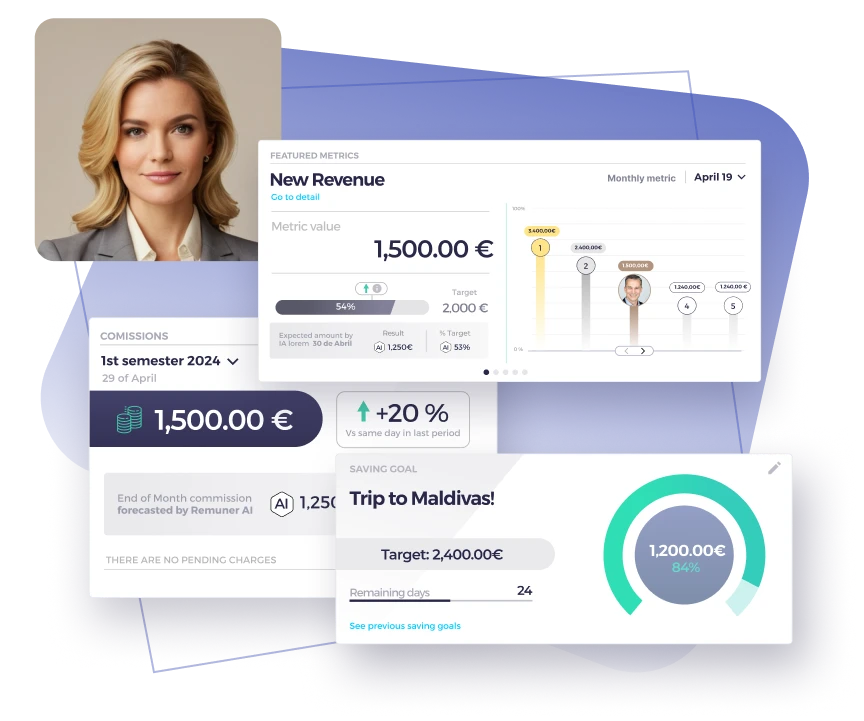Understanding On Target Earnings (OTE) is essential for both employers and employees to ensure fair compensation and motivation. In this post, we will answer common questions about OTE to help you understand this important part of compensation.
Table of contents
What are On Target Earnings (OTE)?
OTE stands for On Target Earnings, which is the total compensation an employee can earn if they meet their performance goals. This includes the base salary plus any additional variable components like bonuses, commissions, and performance incentives.
Why It’s Important:
- Comprehensive Earnings View: OTE provides a clear picture of potential earnings, combining fixed and variable components.
- Attracting Talent: A well-structured OTE can make job offers more attractive to top talent.
- Employee Motivation: Linking earnings to performance can significantly boost motivation and productivity.
How is On Target Earnings Calculated?
Here’s a simple formula to understand the calculation:
OTE = Base Salary + Variable Earnings (bonuses, commissions, etc.)
Example Calculation:
- Base Salary: $65,000
- Potential Bonus: $20,000
- Potential Commission: $10,000
- OTE: $95,000
Key Considerations:
- Realistic Targets: Ensure that performance targets are achievable to maintain employee motivation.
- Regular Review: Review and adjust targets and variable components to reflect changes in business goals or market conditions.
- Communicate and explain OTE calculations clearly to ensure transparency.
On Target Earnings vs. Commission: What’s the Difference?
OTE includes base salary and variable earnings. Companies base commissions on performance, typically as a percentage of sales or achieved targets.
On Target Earnings (OTE):
- Comprehensive Compensation: Includes base salary, bonuses, and other incentives.
- Stability: Provides a stable income base along with performance-linked rewards.
- Flexibility: Adjust OTE based on various roles and duties.
Commission:
- Performance-Based: Directly tied to specific performance metrics, usually sales.
- Variable Income: Can fluctuate significantly based on individual performance.
- Specific Roles: Companies typically use them for sales and business development roles where performance directly links to revenue generation.
Choosing Between OTE and Commission:
- Role Fit: OTE works for jobs with different duties beyond just sales, offering a fair pay deal. Commissions work well for sales-focused roles, where pay matches performance.
- Employee motivation: Commissions motivate sales roles, while OTE motivates employees in various functions to perform well.
What is the Difference Between Base Salary and On Target Earnings?
Base pay gives workers a consistent income. On-Target Earnings encourage workers to exceed performance goals.
Base Salary:
- Fixed Compensation: The guaranteed annual pay an employee receives, regardless of performance.
- Stability: Provides financial stability and security.
- No Performance Link: Not directly tied to performance metrics.
On Target Earnings (OTE):
- Total Compensation: Includes both base salary and variable components like bonuses and commissions.
- Performance-Linked: Tying variable components to meeting specific performance targets.
- A tool to motivate: Encourages employees to achieve higher performance levels to maximize earnings.
Understanding the Differences:
- Financial Security vs. Motivation: A fixed salary ensures financial stability. OTE motivates teams by tying some pay to how well they perform.
- Employer Strategy: Combinin base salary and OTE allows employers to provide financial stability, but it also helps boosting performance.
Best Tools and Software for Calculating and Managing On Target Earnings
Using the correct tools and software for calculating and managing OTE is important in order to improve sales performance. Leveraging top-notch tools helps businesses streamlining their incentive programs and driving sales success.
Factors to consider when choosing the right sales incentive management tool:
- Company Size and Needs: Consider the complexity of your compensation plans. Xactly and Anaplan suit larger organizations, but they struggle significantly when company needs to make adjustments or updates to their plans. Remuner and Spiff, on the contrary, offers flexible and easy-to-adapt solutions.
- Integration Capabilities: Ensure the tool integrates well with existing systems. Remuner and CaptivateIQ excel here.
- User Experience: A user-friendly interface is crucial. Remuner and Spiff offer intuitive platforms.
Remuner:
- Features:
- User-Friendly Interface: Easy for HR and revenue professionals to use.
- Advanced Analytics: Provides deep insights and real-time reporting.
- Customizable Plans: Tailored to meet specific business needs.
- Integration Capabilities: Seamlessly integrates with existing HR and financial systems.
- Benefits:
- Transparency: Clear communication of compensation structures.
- Accuracy: Minimizes errors, enhancing reliability and satisfaction.
- Efficiency: Automates complex calculations, saving time and resources.
Xactly:
- Specialized in Incentive Compensation Management: Ideal for complex compensation structures.
- Detailed Analytics and Forecasting: Helps predict future costs.
- Subtle Weakness: Can be overwhelming for smaller businesses.
Spiff:
- User-Friendly Interface: Easy to navigate and manage compensation plans.
- Integration with main CRM Systems: Ensures accurate and timely calculations.
- Subtle Weakness: Primarily focused on sales commissions, which might not suit all business needs.
CaptivateIQ:
- Focus on Commission Management: Simplifies sales commission calculations.
- Real-Time Insights and Analytics: Helps stay on top of trends.
- Subtle Weakness: Lacks broader capabilities for diverse compensation needs.
In conclusion, when choosing the best sales commission software, Remuner stands above the rest, due to its 100% self-serve platform and the AI sales coach to motivate sales reps sale more. It also has advanced analytics module and integrate seamlessly with any system.

Can On Target Earnings Change Over Time?
The OTE can change over time due to various factors:
1. Performance Adjustments:
- Individual Performance: Adjusting targets based on an individual’s performance can ensure that OTE remains a motivating factor.
- Team Performance: The team can also adjust team-based targets to reflect collective achievements or challenges.
2. Market Conditions:
- Economic Changes: Changes in the economy, such as inflation or recession, can impact OTE structures.
- Industry Trends: Shifts in industry standards or competitive pressures may necessitate adjustments to OTE.
3. Role Changes:
- Promotion: When an employee is promoted, their OTE may need to be adjusted to reflect new responsibilities.
- Role Evolution: As job roles evolve, so too should the OTE to ensure it remains relevant and motivating.
How to Manage Changes:
- Regular Reviews: Conduct regular reviews of OTE plans to ensure they remain aligned with business goals and market conditions.
- Clear Communication: Clearly communicate any changes in OTE to employees, explaining the reasons and how it affects them.
- Align changes in OTE with overall business objectives and performance metrics to ensure alignment with goals.
How Do Employers Set Realistic On Target Earnings?
Setting realistic OTE requires careful consideration of several factors:
1. Benchmarking:
- Industry Standards: Compare OTE with industry benchmarks to remain competitive.
- Competitor Analysis: Analyze what competitors are offering to stay competitive in attracting and retaining talent.
2. Performance Metrics:
- Measurable Targets: Define clear and measurable performance targets that align with business goals.
- Achievability: Ensure that targets are challenging yet achievable to maintain motivation and prevent burnout.
3. Employee Input:
- Engagement: Involve employees in the target-setting process to gain insights and ensure buy-in.
- Feedback: Regularly gather feedback from employees to understand their perspectives and make necessary adjustments.
4. Regular Reviews:
- Performance Alignment: Continuously monitor performance metrics and adjust OTE targets to reflect changes in business goals or market conditions.
- Market Relevance: Regularly update OTE based on market research and industry trends.
Steps to Set Realistic OTE:
- Conduct Thorough Research: Use market data and industry benchmarks to set competitive OTE.
- Define Clear Metrics: Establish clear and achievable performance metrics that align with business objectives.
- Engage Employees: Involve employees in the process to ensure they understand and accept their targets. Make them account
Monitor and Adjust: Regularly review OTE plans and make adjustments based on performance and market changes.





